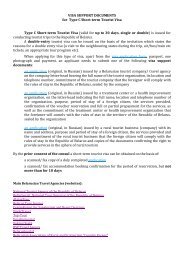Human Development Report 2013 - UNDP
Human Development Report 2013 - UNDP
Human Development Report 2013 - UNDP
You also want an ePaper? Increase the reach of your titles
YUMPU automatically turns print PDFs into web optimized ePapers that Google loves.
States have to beconscious that thenature of growth (and theintensity of labour use insectors that drive growth)evolves as the economytransforms, and to respondwith matching investmentsin people’s skillsover two decades, one study finds thatduring the first decade (1982–1990), 80%of annual economic growth was accountedfor by new employment and capital accumulation.31 Unemployment dropped from20% to below 3%, with the number of jobsgrowing 5.2% a year. Economic growth inthe next decade (1991–1999), however,was driven less by accumulation of capitaland more by the productivity growth ofworkers, a result of investment in humancapabilities. 32• Bangladesh. The more rapid decline inpoverty in the 1990s compared with the1980s 33 was attributed to both the expansionof labour- intensive exports (such as garmentsand fisheries) and the increase in employmentin the rural nonfarm sector (comprisingsmall and cottage industries, constructionand other nontradable services). The stimulus,however, came less from productivityimprovements within this sector than fromrising demand facilitated by an increase incrop production, an inflow of remittancesand growing exports. 34• Rwanda. Expansion in jobs does not alwayshave to come from export-oriented manufacturing.In Rwanda, jobs in tourism serviceshave increased over the past decade. Thesector now sees export earnings that exceedthose from coffee and tea and employs nearly75,000 people. 35• Uganda. Like Rwanda’s, Uganda’s highgrowth during the 1990s was poverty alleviatingbecause of income growth in agriculturethrough large scale absorption of labour,especially in the cash crops sector that wasbuoyed by world prices and improvement inagriculture’s terms of trade. 36• Thailand. Developing countries endowedwith arable land can continue to createstable jobs in agriculture, even thoughits share in total output typically declinesover time. This is the case in Thailand,whose employment pattern of the 1960s iscomparable to that of many Sub-SaharanAfrican countries today. While Thailandhas since become a manufacturing powerhouse,millions of stable jobs continue to becreated in nonmanufacturing sectors suchas retail, hospitality and construction, aswell as in commercial farming: the numberof stable jobs in agriculture increased from519,000 in 1960 to nearly 3 million in2008. Overall, in the 1990s alone, Thailandincreased its share of stable jobs by 11 percentagepoints (as Brazil did between 1970and 1988). 37• Indonesia. Indonesia before the 1997 Asianfinancial crisis stood out for pursuing growththat had a high labour intensity. Real wagesincreased at an average annual rate of 5% fortwo decades preceding the crisis. Between1990 and 1996 alone, formal nonagriculturalemployment increased from 28.1% of theworkforce to 37.9% and the share of workforcein agriculture declined from 55.1%to 43.5%. 38 Post-crisis, when some of thedevelopment gains were reversed, the proportionateincrease in poverty was lowest foragricultural workers. 39As these examples suggest, patterns of growthare rarely consistently pro-poor over consecutivedecades. This is because developmentaltransformation is synonymous with the changein the structure of production and sectors differin their capacities to create jobs. Skilled and unskilledjobs, for example, require a different mixof complementary inputs, such as formal educationand industry-specific training. The largerpoint is that human development–orientedpolicies require both growth and an equitableexpansion of opportunities. <strong>Development</strong>alstates, therefore, have to be conscious that thenature of growth (and the intensity of labouruse in sectors that drive growth) evolves as theeconomy transforms, and they need then torespond with matching investments in people’sskills.Fostering state–marketcomplementaritiesBoth markets and governments can fail, butthere are synergies when they work together.<strong>Development</strong> progress cannot be left tomarkets alone. Some markets not only failto function, but may not exist at all at earlystages of development. Most successful developmentalstates have introduced industrialand related policies that enhance the privatesector’s potential to contribute to human development,especially by creating jobs in newsectors.72 | HUMAN DEVELOPMENT REPORT <strong>2013</strong>
















